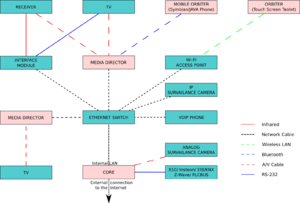Difference between revisions of "Hardware"
From LinuxMCE
| Line 1: | Line 1: | ||
| + | [[Image:Diagram1.jpg|thumb|right|300px|Connectivity possible with LinuxMCE]] | ||
A basic LinuxMCE system can be set up with relatively modest PC and networking hardware. More advanced (though not necessarily expensive) systems can work with virtually any device that allows some form of input/output control capability. This might be through ethernet, infrared, [http://en.wikipedia.org/wiki/RS-232 RS232] or a home control protocol such as [[X10]]. | A basic LinuxMCE system can be set up with relatively modest PC and networking hardware. More advanced (though not necessarily expensive) systems can work with virtually any device that allows some form of input/output control capability. This might be through ethernet, infrared, [http://en.wikipedia.org/wiki/RS-232 RS232] or a home control protocol such as [[X10]]. | ||
Revision as of 22:30, 26 September 2007
A basic LinuxMCE system can be set up with relatively modest PC and networking hardware. More advanced (though not necessarily expensive) systems can work with virtually any device that allows some form of input/output control capability. This might be through ethernet, infrared, RS232 or a home control protocol such as X10.
- See hardware requirements at What hardware I will need?
- Check out the hardware category for an organised list of hardware
LinuxMCE hardware terms
Here is a list of LinuxMCE-specific hardware terms.
- Core - a PC which is the centre of your system
- Media director - PC devices which are connected to your core and provide
- Orbiter - one or more lightweight portable devices used to control the system
